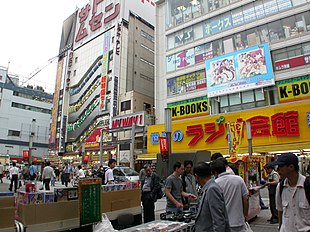
Otaku (Japanese: おたく, オタク, or ヲタク) is a Japanese word that describes people with consuming interests, particularly in anime, manga, video games, or computers. Its contemporary use originated with a 1983 essay by Akio Nakamori in Manga Burikko.
Otaku subculture is a central theme of various anime, manga, documentaries, and academic research. The subculture began in the 1980s as changing social mentalities and the nurturing of otaku traits by Japanese schools combined with the resignation of such individuals to what was then seen as inevitably becoming social outcasts. The subculture's birth coincided with the anime boom after the release of works such as Mobile Suit Gundam, before it branched into Comic Market. The otaku culture could also be seen as a refuge from the nanpa culture. In 1980, around the Kabuki-chō district of Shinjuku in Tokyo, there was a boom of nyū fūzoku, or new sex services employing female college or vocational school students. The burusera boom and the compensated dating boom in the 1990s were extensions of this. In this sense, the period from 1980 to the mid-1990s was the "age of sexual love". The higher the sexual love boom rose, the more people were disappointed in sexual love for not giving them that comprehensive acceptance. The advent of information technology and databases, first and foremost, enriched the means for the homeostasis of the self, that is, self-defense; and, secondly, it thereby rapidly weakened the sense that "reality" (or embodied communication) is more fruitful than "fiction" (or virtual reality).[1] The otaku subculture grew with the expansion of the Internet and media, as more anime, video games, shows, and comics were created.[2] The definition of otaku subsequently became more complex, and numerous classifications of otaku emerged.
Otaku may be used as a pejorative, with its negativity stemming from a stereotypical view of otaku as social outcasts and the media's reporting on Tsutomu Miyazaki, "The Otaku Murderer", in 1989. Otaku discrimination was particularly intense between 1989 (when a serial murder suspect was arrested) and 1996 (when the compensated dating boom was at its peak).[1] According to studies published in 2013, the term has become less negative, and an increasing number of people now identify themselves as otaku,[3] both in Japan and elsewhere. Out of 137,734 teens surveyed in Japan in 2013, 42.2% self-identified as a type of otaku.[3] According to a nationwide U.S. survey conducted by Dentsu in July 2022, 34% of American Gen-Zs (around 15 million people), acknowledged themselves as anime otaku.[4] In 2005, the Nomura Research Institute divided otaku into twelve groups and estimated the size and market impact of each of these groups. Other institutions have split it further or focused on a single otaku interest. These publications classify distinct groups including anime, manga, camera, automobile, J-idol, and electronics otaku. In 2005, the economic impact of otaku was estimated to be as high as ¥2 trillion (US$18 billion).[5]
- ^ a b Miyadai, Shinji (2011). "Transformation of Semantics in the History of Japanese Subcultures since 1992". Mechademia. 6: 231–258. doi:10.1353/mec.2011.0012.
- ^ Okamoto, Takeshi (2014). "Otaku Tourism and the Anime Pilgrimage Phenomenon in Japan". Japan Forum. 27: 12–36. doi:10.1080/09555803.2014.962565. S2CID 145267918.
- ^ "The Numbers Speak for Themselves! Anime is Killer Content for Gen Z". Dentsu. December 4, 2023.
- ^ Cite error: The named reference
moneywas invoked but never defined (see the help page).